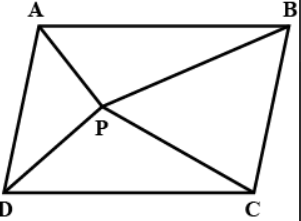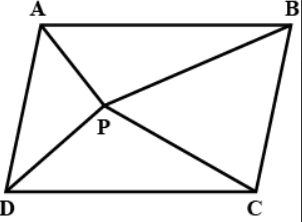a,b,c,d ∈R+ such that a,b and c are in H.P and ap.bq, and cr are in G.P then pr+rp is equal to Solution in Bengali
ab=cd
ac=bd
bc=ad
none of these
The correct Answer is:C
2b=a+c,c=2bdb+d
⇒2bd=c(b+d)
⇒(a+c)d=c(b+d) [as 2b=a+c]
⇒ad+cd=bc+cd
⇒bc=ad
Topper's Solved these Questions
- PROGRESSION AND SERIESBOOK - CENGAGE PUBLICATIONCHAPTER - PROGRESSION AND SERIESEXERCISE - EXERCIESE ( MULTIPLE CORRECT ANSWER TYPE )
66 Videos
- PROGRESSION AND SERIESBOOK - CENGAGE PUBLICATIONCHAPTER - PROGRESSION AND SERIESEXERCISE - EXERCIESE ( LINKED COMPREHENSION TYPE )
60 Videos
- PROGRESSION AND SERIESBOOK - CENGAGE PUBLICATIONCHAPTER - PROGRESSION AND SERIESEXERCISE - CONCEPT APPLICATION EXERICISE 5.9
9 Videos
- PROBABILITY IIBOOK - CENGAGE PUBLICATIONCHAPTER - PROBABILITY IIEXERCISE - MULTIPLE CORRECT ANSWER TYPE
6 Videos
- PROPERTIES AND SOLUTIONS OF TRIANGLEBOOK - CENGAGE PUBLICATIONCHAPTER - PROPERTIES AND SOLUTIONS OF TRIANGLEEXERCISE - Archives (Numerical Value Type)
3 Videos
Similar Questions
For an increasing A.P. a1,a2,anifa1=a2+a3+a5=−12 and a1a3a5=80, then which of the following is/are true? a1=−10 b. a2=−1 c. a3=−4 d. a5=+2
View SolutionFor an increasing A.P. a1,a2,anifa1=a2+a3+a5=−12 and a1a3a5=80, then which of the following is/are true? a1=−10 b. a2=−1 c. a3=−4 d. a5=+2
View SolutionFind the sum of infinite series
11×3×5+13×5×7+15×7×9+….
View SolutionLet EandF be two independent events. The probability that exactly one of them occurs is 1125 and the probability if none of them occurring is 225. If P(T) denotes the probability of occurrence of the event T, then (a) P(E)=45,P(F)=35 (b) P(E)=15,P(F)=25 (c) P(E)=25,P(F)=15 (d) P(E)=35,P(F)=45
View SolutionLet ABCandABC' be two non-congruent triangles with sides AB=4,AC=AC′=2√2 and angle B=300 . The absolute value of the difference between the areas of these triangles is
View SolutionIn Figure, P is a point in the interior of a parallelogram ABCD . Show that ar(APB)+ar(PCD)=12ar(^(gm)ABCD) aR(APD)+ar(PBC)=ar(APB)+ar(PCD)

View SolutionIf a,b,andc are in A.P. p,q,andr are in H.P., and ap,bq,andcr are in G.P., then pr+rp is equal to ac−ca b. ac+ca c. bq+qb d. bq−qb
View SolutionIf a, b, c be the pth, qth and rth terms of a G.P., then (q-r) log a+ (r- p)log b+ (p-q) log c is equal to (A) 0 (B) abc (C) ap+bq+cr (D) none of these
View SolutionIf p^(a)=q^(b)=r^(c)=s^(d) and p,q,r,s are in G.P then a,b,c,d are in
View SolutionIn Figure, P is a point in the interior of a parallelogram ABCD. Show that ar(APB)+ar(PCD)=12ar (||gmABCD) ar (APD)+ar (PBC)=ar (APB)+ar(PCD)

View SolutionIf a, b, c, are in A.P. ., p , q,r, are in H.P. and ap ,bq, cr
are in G.P. then
View SolutionIf a,b,c are in A.P., p,q,r are in H.P and ap, bq, cr are in G.P., then pr+rp =
View SolutionLet , a , b ,c ,d , p ,q ,r be positive real number such that a ,b , c are in G.P and ap=bq=cr Then-
View SolutionIf a, b, c are in A.P., p, q, r are in HP and ap, bq, cr are in GP, then Pr+rP is equal to
View SolutionIf the pth, qth, rth, and sth terms of an A.P. are in G.P., then p−q,q−r,r−s are in a. A.P. b. G.P. c. H.P. d. none of these
View SolutionIf a,b,andc are in A.P. p,q,andr are in H.P., and ap,bq,andcr are in G.P., then pr+rp is equal to a/c+c/a
View Solution
